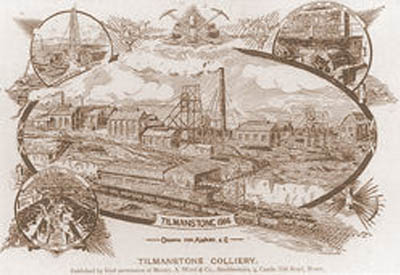
history |
On average over 200 unique visitors download this page, thats over 70,000 visitors per year and rising. Advertsie your business on this website and support your local ex-miners community |
|---|

Tilmanstone CollieryIn 1911 The Anglo Westphalian Coal Syndicates Ltd decided to explore the possibility of workable coal seams in the Canterbury area ,after the sinking of bore holes in the area they put forward plans to sink two shafts on land at Chislet Park with the possibility of opening up The Sarre Pen to take the coal away by sea at Reculver.Also known as the East Kent Colliery, Tilmanstone was begun near the village of Eythorne in 1906 by Arthur Burr by Arthur Burr’s Foncage Syndicate and then managed by his East Kent Colliery Co. Ltd. Like all the Kent collieries it suffered from bad geology and poor investment. In 1909 a hoppit (hoist bucket) fell down the shaft, killing three men and destroying the pump pipes. One thousand gallons of water a minute poured into the pit and work was abandoned for 9 months. Work on sinking the shaft started again in 1910 but it kept hitting water which brought with it tons of sands. Sinking continued slowly until electric pumps were installed in 1912. The coal seams were reached in 1912 and in March 1913 the rich Beresford seam was hit at a depth of 1560 ft. (476 m.) and commercial production of coal commenced. Despite this, the company was in serious financial trouble and went into receivership in 1914. Burr was dismissed and the shareholders rescued the company and took over the management. The colliery still struggled, losing money every year, and in 1926 it was again in receivership and was sold to Richard Tilden Smith and his Tilmanstone (Kent) Colliery Ltd. The rich Milyard seam was hit in May 1930 at a depth of 3,035 ft. (925 m.) His aim was to export coal from Dover, but the only method of transportation available was via rail, which was not only slow, but expensive. He proposed to build an arial ropeway to move coal from the Colliery directly to Dover harbour, but his application was turned down. However he managed to get agreement from Dover Harbour Board to site a 5000 ton Bunker on the Eastern Arm, and contributed £25,000 to the building costs. When built it was capable of moving 120 tons of coal per hour, each bucket holding 14.5cwt. A bucket left the colliery every 21 seconds and they were spaced 46 yards apart. The first section of the ropeway was opened on October 12th 1929, between the Colliery and East Langdon. The “Cormister” was the first vessel to be loaded with Tilmanstone coal on February 14th 1930, when Tilden Smith himself pressed the button. The coal was loaded at 500 tons per hour. Tilden Smith died in December 1929 and in 1937 his interests were sold to the Anglo-French Consolidated Investment Corporation Ltd. They planned to develop the lower seam as the Colliery was not working to it’s full capacity. Tilmanstone was extensively modernised after nationalisation in 1947 but was always considered uneconomic by the NCB. It was planned to close it as early as 1967 but survived until 1986. |
|
|---|

